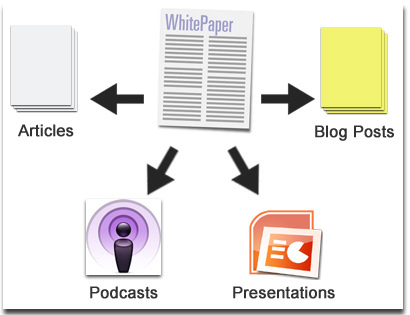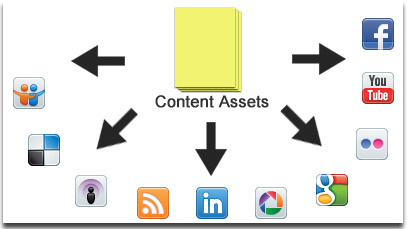How To Get The Most Search Engine Marketing Value From Key Content Initiatives
One of the major obstacles marketers face, particularly with B2B search engine marketing, is the availability of content to support keyword initiatives. While we realize the importance of new content, the demand for time and resources will always be tested. The key to success: don’t try to reinvent the wheel every time new content is […]
One of the major obstacles marketers face, particularly with B2B search engine marketing, is the availability of content to support keyword initiatives. While we realize the importance of new content, the demand for time and resources will always be tested. The key to success: don’t try to reinvent the wheel every time new content is required.
In this article, we’ll explore several areas of content creation and distribution which can assist in creating effective B2B content marketing strategies and support search engine optimization initiatives.
The Core Foundation: Value Extraction
Many of the B2B organizations we have worked with have had a content plan that usually includes two to four major content pieces (per year). This typically includes development of marketing assets such as white papers, industry research, etc.
The foundation for content creation is simple: extract maximum value from all of your organizations key content assets. The graphic below is meant to help illustrate this concept.
These type of assets are loaded with valuable resources, spanning multiple points. You can re-purpose one solid white paper into a combination of several supporting content assets.
At a basic level, this information can be the basis for initiatives such as a series of blog posts, or articles and bylines that can then be leveraged for link building requests.
Take that concept one step further. With a little more creativity, a solid content asset can be spun into a webinar, podcast, or video. If your team (or your search engine marketer) is graphically inclined, perhaps a visualization or graphical outline of a concept is also possible.
With scarce resources and time, it is imperative to unlock as many supporting content opportunities as possible from these key content assets planned in the annual marketing calendar.
Keyword Optimization
Keyword research goes hand-in-hand with the development of all content assets, primary and supporting. In the ideal setting, the search marketer has input from the start. In most cases, we tend to get asked about keyword strategy after the initial concept has been defined.
For the latter, it still can be a fixable problem. If the organization has invested in an SEO strategy, core content assets most likely have a keyword focus already in mind; even without specific input. A search marketers job is to uncover the real gems and potential longer tail keyword opportunities based off of a core keyword theme.
Here is a high level example:
For one of our clients, keyword research for supporting content assets, derived from one content-rich white paper, led to over a dozen actionable longer-tail keyword strategies, with measurable search engine volume based off of keyword tools and historical PPC data.
Most likely, there are additional keyword opportunities that can be derived from one or two competitive keyword themes. Make sure to use historical PPC data, competitive analysis, and keyword tools to uncover keywords that can be applied to these newly developed content assets.
Content Distribution
Now that you have the content developed, it’s time to get the message out. The graphic below is meant to illustrate the various potential social sites and communities where this material (as well as the primary content developed) can be distributed.
Make every attempt to post and promote your material as best as possible, using methods as appropriate for each community.
Beyond content developed solely to be placed on the company website or blog, consider how articles and blog posts may be used for link building assets as well. We have had success drafting articles from deeper research and white papers, which ultimately were accepted as bylines, in industry publications. Guest posts on industry blogs are also be possible if the right relationships have been made.
There are niche social media networks for sharing almost every type of creative asset, from the most popular like YouTube and Flickr, to more niche networks like Docstoc or Slideshare. Do not forget to create links to related website information in applicable description fields as well when uploading. Even if links are “nofollow” they can still attract the right click-throughs if your target market is also using these communities.
The B2B Lead Funnel
The final piece of the puzzle is in tying conversion initiatives into the content generation process. At a basic level, core content assets can be incorporated into a landing page for lead generation. Instead of simply directing visitors to only the form, develop introductory content, around that form, with keyword strategy in mind.
A basic outline that we have found to be successful is as follows: a few leading sentences, around three bullet points highlighting important concepts or key takeaways, and a clear call-to-action to the form submission.
For your supporting content assets, make sure to track referral data in through web analytics. Establish reporting metrics for both unique referral traffic and returning prospects that follow and click-through to visit or view your content as well.
Wrapping Up: Get More Mileage For Your Efforts
Generating new content for your B2B search engine marketing efforts does not always rely on completely new ideas, week after week, or month after month.
Focus on deriving the most value by extracting smaller, more concise pieces out of deeper material like white papers, research studies, and other key content initiatives.
Content goes beyond the traditional, written article as well.
Assets such as video, graphics, and presentations can be used to populate supporting sections of the website or utilized for link building and social media initiatives as well.
Finally, do not forget to tie your content initiatives around conversion metrics, including form submissions and click-throughs from targeted prospects and customers.
Contributing authors are invited to create content for Search Engine Land and are chosen for their expertise and contribution to the search community. Our contributors work under the oversight of the editorial staff and contributions are checked for quality and relevance to our readers. The opinions they express are their own.
Related stories
New on Search Engine Land

